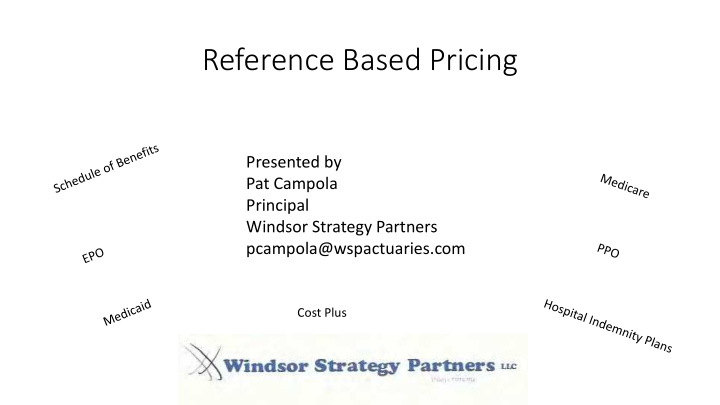



Reference Based Pricing Presented by Pat Campola Principal Windsor Strategy Partners pcampola@wspactuaries.com Cost Plus
Reference Based Pricing Pat Campola
• Windsor Strategy Partners • Princeton N. J. Ted Wilson John Marshall FSA Analyst
The hospital billing system today is not consistent between the populations they serve. Hospitals charge on average 4 times the cost to deliver their services. * Complex tests and services such as cat scans and anesthesia are sometimes billed at 25 times their actual costs**. Billing practices are different for Retail (no insurance), PPO, Medicare and Medicaid Patients. The more patients you can deliver to a hospital the higher the discounts. Hospitals in rural or less competitive markets are unlikely to negotiate their fees. If the free market cannot solve these disparities the government will. * RevCycleintelligence article ** HUB article
Reference Based Pricing for Self Insured plans An attempt at a payment system that is driven by employers. Using a percentage of what Medicare pays as the amount a self insured plan will pay.
How does Medicare Determine what they will Pay?-Diagnosis Related Group (DRG) • In order for a hospital to be an approved Medicare facility it must file its actual cost data with Medicare. • Medicare hospital payments are determined through the Diagnosis Related Group (DRG) assigned to the principal diagnosis causing the hospitalization and any complications thereof. • The DRG code relates to a set payment amount developed for that particular hospital. • DRG codes consist of 20 major body systems subdivided into 500 groups.
Comparing PPO and Medicare to Billed Charges • Average PPO Discount: • Medicare Equivalent Discount: • 100%- 84.5% • 110%- 82.9% • 120%- 81.4% • 130%- 79.9% • 56% • 140%- 78.3% • 150%- 76.7% • 160%-75.2% • 170%-73.6% • 180%-72.1% • 190%-70.3% • 200%-69.0% * Source- Windsor Risk Decision Support Model.
Issues Impacting Reference Based Pricing • Hospitals/Physicians; • Employees; • Advocacy Firms; • Claims adjudication; • Self Insured Plan Design; • Where is RBP heading?
Questions for Hospitals and Physicians • Can they deny treatment? • Can they balance bill? • Can you have hospital benefits paid under a percentage of Medicare and contract with a physician's network. • What motivates a hospital to accept payment based on RBP? • Difference between PPO arrangement and RBP- “Contract”
Issues/Opportunities for Employee/Employer • Understanding and supporting the employers’ motives to control what is paid. • Educate the employees on the billing differences between Retail, PPO, and Medicare. Hold regular meeting to discuss issues. • Use the savings achieved to improve benefits being provided or reduce the employees cost for coverage. There can be a win win. • A benefit to employees, freedom from networks or need for referrals. • Set up advocacy help to negotiate balance billing.
Claims Adjudication-Questions for Administrator • How long has the TPA been administrating RBP? You don’t want to go through a learning curve with them. • How does the administrator convert billed charges to a percentage of Medicare. • Is your RBP over just in-patient hospital or all services where applicable. • Ask to see sample plan document language. It has to be very specific as to when RBP is used. • Do you have an advocacy service?
Advocacy • Companies that negotiate with Hospitals to accept the RBP payment; • Co-Fiduciary; • Providers of legal assistance for billing disputes; • Employer and Employee education; • Plan Document Drafting; • Subrogation; • Direct Contracting
How Advocacy Companies are paid can impact your stop loss costs. • Partial List of Advocacy Companies • Advanced Medical Pricing Solutions- AMPS • Allied National Companies • Claim watcher/Homestead • ELAP • HSTechnology- HST • PayerCompass
Comparing PPO and Medicare to Billed Charges-Is it worth it? • Average PPO Discount: • Medicare Equivalent Discount: • 100%- 84.5% • 110%- 82.9% • 120%- 81.4% • 130%- 79.9% • 56% • 140%- 78.3% • 150%- 76.7% • 160%-75.2% • 170%-73.6% • 180%-72.1% • 190%-70.3% • 200%-69.0% * Source- Windsor Risk Decision Support Model.
Where is RBP Heading • This is a moving target that will change before it settles. • Expect legal challenges to shape it’s future. • Somewhere between 100% of Medicare and average PPO discounting is a happy median that both employers and providers should be able to agree on. • Contracting with providers will increase largely driven by advocacy firms who are regularly negotiating with these providers. • The advocacy firms will look more and more like a PPO within a given region. • As more government entities adopt RPB it will further set the stage for legislation that establishes Medicare as the most common basis for paying claims. • RBP will be a another step toward the eventual development of a single payer system.
Happy Holidays to Everyone
Recommend
More recommend